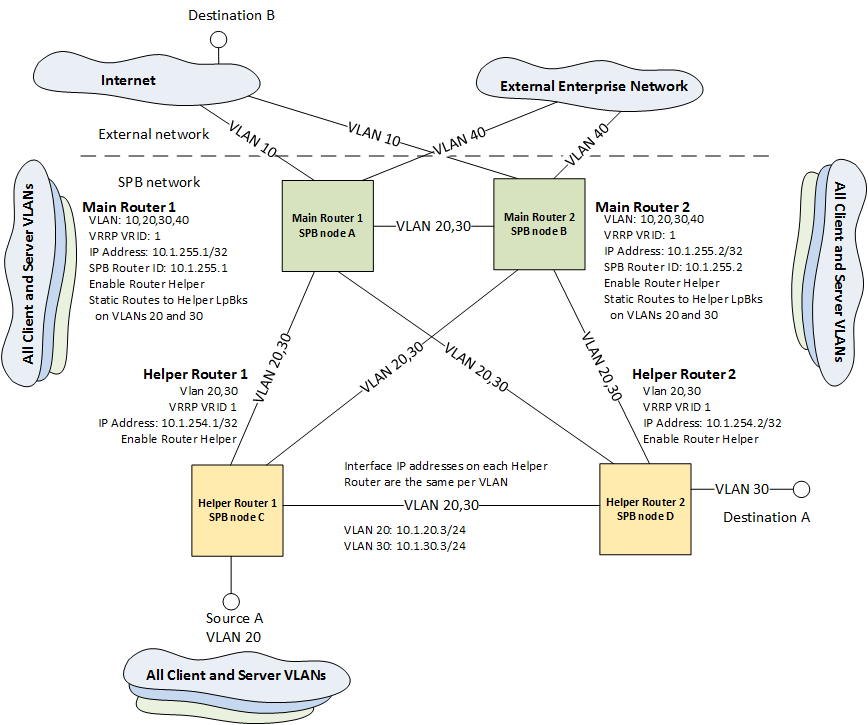Routing as a Service (RaaS), also known as Virtual Fabric Routing, provides for scalable and efficient virtualized routing over any L2 SPB network infrastructure by scaling the fabric from a single chassis to a collection of devices that use L2 protocols to form its topology. The L2 topology protocol can form a single path service like Spanning Tree or a multipath service like Shortest Path Bridging (SPB). RaaS presumes the L2 service can proliferate all VLANs to all devices.
RaaS offers a routing solution that efficiently utilizes the L2 infrastructure by leveraging its topology protocols in place of L3 protocols. RaaS supports the establishment of a network-wide, distributed virtual routing system where all of the devices in the SPB network work as a single and collective layer 3 forwarding mechanism, allowing routing to become an integrated service of the layer-2 domain.
RaaS functions within a SPB network. SPB is an emerging layer 2 technology defined by IEEE that augments Spanning Tree to utilize multiple paths and defines Shortes Path Bridging VLANs (SPBV). In a traditional SPBV network, routers attach at the edge to forward traffic between customer VLANS. Although a viable solution, routing at the edge of the SPB network typically does not provide the most direct path through the network. Routed packets first egress the layer-2 network on one VLAN to a connecting router which forwards them onto another VLAN within the same layer-2 network, thereby traversing the layer-2 network twice.
RaaS provides an integrated routing service that leverages layer-2 features such as VLAN propagation, multipath topology, fast convergence, and MAC reachability to provide a simpler and efficient routing service that eliminates all routing protocols within the SPB network. By eliminating routing protocols, this feature can scale to support routing across the VLAN interfaces that may be present in an SPB domain.
There are two types of routers within an RaaS network:
RaaS counts on hosts within a layer-2 domain being no more than one routed hop away. Assuming all VLAN interfaces are on every edge device, RaaS Helper Routers route directly to their destinations using layer-2 services to perform the multipath and MAC reachability. Packets are forwarded to a Main Router only when an RaaS client cannot route the packet. RaaS distributes routing throughout the SPB network leaving more complex IP forwarding to a few selected Main Routers.
RaaS helper routing devices utilize virtual IP addressing concepts described by VRRP allowing for simple and shared routing configurations to be deployed on all participating devices.
The following figure displays an RaaS overview.

Helper Routers 1 and 2 are each configured for VLANs 20 and 30, with VRRP configured for VRID 1, and the Helper router feature enabled on the VRRP. A packet on Source A VLAN 20 destined for Destination A on VLAN 30 will be routed by Helper Router 1 then forwarded to Destination A over the shortest path through Helper Router 2. In a non-RaaS configuration, the packet would first be forwarded to Main Router 1 or 2 which would forward the packet to Helper Router 2.
Main Routers 1 and 2 are configured for VLANs 10, 20, 30, and 40, with VRRP configured for VRID 1 on VLANs 20 and 30, and SPB router ID 192.168.255.1 and .2 respectively. Static routes are configured on each Main Router for the Loopback addesses on VLANs 20 and 30. All Helper routers on VRID 1 are aware of Main Router 1 through the SPB router ID configuration.
A packet sourced on Source A VLAN 20 with a destination of Destination B on VLAN 10 will be forwarded to the Main Router 1 on the shortest path then routed to VLAN 10, destination C.

 Print
this page
Print
this page Email this topic
Email this topic Feedback
Feedback